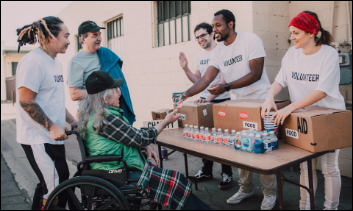The new normal is a shade greener in Florida: Legal medical marijuana is now widely available in Tampa Bay. Though the community has had a contentious relationship with pot, cannabis dispensaries are now as easy to find hereabouts as Amscots. They are convenient and well-regulated, and maybe not exactly what you pictured — a world away from the canna cafes in Amsterdam. Here, dispensary shops are clinical, hygienic with modern, minimalistic decor: Think dentist office meets Apple store. The person helping you is trained in the nuances of various strains, Indica, Sativa and hybrids. Employees have professional titles like “care consultant.” They answer questions and match your symptoms with a strain to make sure you get the relief you need. FL Dispensaries, an online resource for all products and businesses in the state that are related to cannabis, has one of the best, most easy-to-understand explanations of why our bodies were built to respond to cannabis’s properties. The website goes into the two types of receptors — CB1 receptors mostly found in the brain, and CB2 receptors, which are found throughout the body — and talks about how cannabinoids are also known to have antioxidant, antibiotic, antiviral and antifungal properties. “Essentially the biochemical structure of cannabinoids allows it to latch onto molecules in germs thereby rendering them harmless,” the site says. No matter how you dress it up in business casual, though, weed culture’s irreverent absurdities creep in. The goofy names of marijuana strains remain. You can purchase anything from Maui Wowie to Banana Hammock to Lucinda Williams in our state. (Find out more at fldispensaries.com.) One medical marijuana card-carrier we know, who asked us to identify her as Miss Wyatt, was surprised by how dispensaries operate in Florida: “They don’t refer to it as bud; they call it flower,” she says. “It’s not like out West where everything’s in jars and you can see it all.” You’re first greeted by a receptionist, she says. After you’re called, a salesperson will hand you a list with one side having indica on the left, sativa on the right, and hybrids in the middle. “Indica is more for physical pain and it makes you wanna kick back on the couch. Whereas the sativa is more a mental thing. That’s the one that makes you giggle and want to get up and clean the house and bake cookies.” In her mid-50s with a sassy Southern accent, Wyatt lives in Clearwater. She has two pet goats and is waif-thin despite having put on a few pounds in the past months. Her general practitioner recommended she use cannabis with THC to gain weight. She says she’s been happy with it so far and shops at different dispensaries to take advantage of their sales and promotions. Allowed 2.5 ounces of flower a month, Wyatt says her purchases are entered into a state-managed database, so she can’t buy more than the legal limit. Her experience at Surterra was “fancy but not as friendly as the others, but the product was really good.” Fluent has the best customer service but not the best selection, she feels. Trulieve is her favorite because the customer service is pleasant and professional, and she likes their variety of strains.
It’s in the Cards
What’s involved with getting a medical marijuana card? The first step is to seek a diagnosis by a qualified marijuana doctor who will make the recommendation to the state that you qualify for a medical marijuana card. Doctors are listed online or you can find one in the searchable database at the Florida Department of Health’s Office of Medical Marijuana Use (OMMU). To qualify as a patient, you must show that you have one of the approved conditions and you’ve tried other treatments that haven’t worked. ALS, anxiety, anorexia, arthritis, cancer, epilepsy, glaucoma, HIV/AIDS, PTSD, Crohn’s disease, Parkinson’s, chronic nonmalignant pain and multiple sclerosis (MS) all qualify. After your consultation with the recommending doctor, your name and email are entered into the Medical Marijuana Use Registry. Once the application is approved, patients can use their state-issued card to purchase a modest amount at one time, around an eighth of an ounce of smokable cannabis with THC, and up to 2.5 ounces of whole flower cannabis every 35 days. Fox Tampa Bay reported that the medical cannabis industry has reported a 30 percent increase in profits since the COVID-19 social distancing guidelines were imposed, and has averaged 300 new medical cardholders a day. Dispensaries, like any other business, are finding ways to adapt to the guidelines. ALTMED, which operates 19 Florida dispensaries, has adopted a “no guests” policy, admitting only patients and requiring them to wait outside after registering with receptionists and closing the stores on Sundays “to facilitate deep cleaning and sanitizing.” ALTMED’s MüV cannabis products are available by delivery within 20 miles of the store locations. Your CBD Store, a sharply appointed boutique-like shop in Largo, offers curbside pickup and free delivery within a 10-mile radius.
If It’s Good for Mom…
Your CBD Store(1901 W. Bay Drive #7, Largo, 727-509-3403) isn’t just distinctive because of its good looks (or that of its co-owners, the movie star-attractive newlyweds Jessica and Chris Hargiss). The company’s transparency and product quality has earned them several industry awards, including certification by the U.S. Department of Agriculture, and their lab-tested products include a QR code on the label that you can scan with your phone to find out about their laboratory test results. You cannot buy products with euphoric levels of THC at Your CBD Store. The shop emphasizes the therapeutic, not recreational, use of cannabis. One of their newest products, by Sunflora.org, offers pain relief via a roll-on for athletes. It has Lidocaine and 25 mg of CBD. “From runners to just people with joint pain, people have really liked it,” Jessica said. Free bottles of hand sanitizer are available to customers who purchase $75 or more. On the counter, a laminated chart illustrates all the ailments that can be treated with CBD, a non-euphoric but essential component of marijuana. Maladies like intestinal distress, anxiety, seizures and chronic pain and many more are listed. Jessica’s involvement with CBD goes back a few years, when she was in dental school at Temple University. Jessica’s mother had cancer and opted for a homeopathic treatment that involved an IV drip with a high-potency extract of the plant-derived remedy and Vitamin C. When her mom went into remission, she realized her calling to educate the public and provide CBD’s all-natural relief. “Most of our customers are looking for alternatives to prescription drugs for pain, inflammation, anxiety, insomnia and many more conditions,” she explained. “The majority of our customers are between the ages of 50 and 85-plus. … Our customer base has grown massively, and the results can be seen widespread.” According to Healthline, a 2019 review of in vitro and in vivo studies focusing on pancreatic cancer found that cannabinoids can help slow tumor growth, reduce tumor invasion and induce tumor cell death.A compassionate cannonballIn Pinellas Park, another cancer survivor and cannabis entrepreneur witnessed firsthand how pharmaceuticals cost patients more than money. Trichom Health Center owner and founder Alisha Kelley said she went into a coma and almost died. She’s one of many whose renewed vitality has inspired a new life calling.
Chatting with me on the phone, Kelley describes how she was anti-marijuana for years. Around 15 years ago, her husband was in treatment for bipolar disorder, and the cocktail of meds he was taking — Seroquel, Lithium, Wellbutrin and Paxil — had strange side effects, producing what she described as zombie-like behavior with random outbursts. He quit the meds and started to smoke pot. Kelley was worried that he would get caught, but she began to realize that he was responding positively to the herb. It helped stabilize his moods. He became a “happy-go-lucky chill guy,” she says. In 2015, when Kelley was diagnosed with breast cancer, she went the traditional route at first and had surgery, which left her with a debilitating condition, hypocalcemia: an inability to absorb calcium and other minerals. She claims that she could have saved money, time and pain if she’d let CBD oil slow her tumor growth, and she uses it now to manage her pain. After her hospital stay, Kelley started working at a pain management clinic and helped run its first medical marijuana program. “We started seeing our patients’ cancer going into remission and they were using fewer pain meds, they weren’t overdosing from the benzodiazepines and the narcotics. And then I started to see patients were getting overcharged. I mean, you’re talking anywhere from $200 to $500 a visit.” Before the Florida’s Department of Health started regulating the industry in 2017, there were local doctors who were meeting patients in hotels and conference rooms, taking their money, not putting their orders in and overcharging them. “It was bad,” she said. “So after seeing all of this, I finally said, ‘You know what, I’m done.’ I want to do something for people. I want to help the patients. I advocate enough for them, on my own. So let’s do it. I put my house up against a loan with the help of a close family member and opened my own office.” Kelley’s compassion shows in her business practices. Her clinic offers 15 percent off for veterans and 50 percent off for veterans with PTSD. “Veterans are very near and dear to my heart,” she says. Trichom also offers 50 percent off for cannabis industry employees “because, you know, they don’t get a lot of discounts.” Like the misunderstood and underestimated herb itself, Kelley is a far cry from a conventional businessperson. Even so, the Pinellas Park Chamber of Commerce nominated her for membership in recognition of her assistance in putting pill mills and methadone clinics out of business, and community outreach. “I have bright red hair. I have tattoos,” Kelley says unapologetically. “If you come into my office, I’m usually wearing ripped jeans because I’m not going to pretend that I’m somebody different. … They call me the cannonball because somebody once said to me, you need to make ripples to make a difference.”
A Checkered Past
Over the past century, Tampa Bay locales have figured prominently, if infamously, in cannabis history. A grisly event in Ybor City revealed how cultural prejudice has shaped marijuana’s criminal profile. In 1933, Victor Licata, the 21-year-old son of a popular Italian barber, brutally murdered his mother, father, brother and sister with an ax. Police blamed the young man’s “lunacy” on “moonshine and marijuana.” Diagnosed with dementia and schizophrenia by clinicians who didn’t connect his condition to marijuana, Victor nonetheless became a poster child in the government’s campaign against marijuana. “White establishment Tampa — and its mouthpiece, the press — created a ‘Reefer Madness’ story out of the scantiest and most unreliable evidence,” said Maureen Patrick, local scholar and former president of Tampa Historical Society. “The real story was the persistent campaign to paint the ethnic enclave of Ybor City in the most negative colors possible. From 1908, when a sheriff quoted in the Tampa Morning Tribune described the Ybor City population as ‘composed largely of Spaniards [who] want to sell liquor, are surly, and gamble all the time,’ there was an unbroken tradition of racial slurs and stereotyping that extended to and beyond the Licata murders.” Harry Anslinger, commissioner of the Federal Bureau of Narcotics in the 1930s and ’40s, used the Licata case as evidence that marijuana use caused insanity and criminal behavior.. His 1937 article “Marijuana, Assassin of Youth” connected the tragedy to marijuana abuse, which he cited during his testimony at the congressional hearings for the Marijuana Tax Act of 1937. Licata, who wasn’t fit to stand trial, committed suicide by hanging in a state mental hospital in 1950. The language in the tax law made pot illegal, and disproportionate minority pot arrests followed for decades. In the 1960s, college students and hippies began to bring “grass” back into vogue. In the early 1970s, surfer John Lamb of St. Pete Beach, just shy of 20, and six of his cohorts made up the Steinhatchee Seven, known for smuggling in the most marijuana caught by law enforcement at the time — nine tons — onto Florida’s Gulf Coast shores. One of the seven later assisted George W. Bush’s revamp of the War on Drugs. After Clinton’s Three Strikes law, as many as 88 percent of drug arrests included marijuana possession. As studies emerged from other parts of the world, news of the therapeutic qualities of cannabis filled the media, and its stigma as a gateway drug became widely disputed in the scientific community. Backwards and forwardsLegal cannabis still has its detractors. One of its most prominent opponents, Bertha Madras, is a Harvard professor who has the ear of state legislatures and President Trump. She’s to the legalization movement what Phyllis Schlafly was to the failed Equal Rights Amendment — not a hair out of place and armed with advanced degrees. A member of the U.S. Commission on Combating Drug Addiction and the Opioid Crisis, Madras has spoken before the State House on how the social acceptance of marijuana mirrors the normalization of opioid use in the early 2000s. “Marijuana is not benign. It is not safe. It is addictive,” she told the Tallahassee Democrat. She’s been widely criticized for citing research that fails to provide context and take into account mitigating factors.
“The data that I have seen on THC don’t support the statements that Dr. Madras is making,” says Dr. Alan Shackelford, a medical doctor behind young Charlotte Figi’s epilepsy breakthrough, which led to the naming and legalization of a therapeutic low-THC cannabis strain known as Charlotte’s Web. He emphasizes that he practices “evidence-based medicine.” “There’s an institutional bias against cannabis in the U.S.,” he adds, explaining how more research dollars go to exploring ways marijuana causes harm than its many therapeutic properties. The results Dr. Shackelford has witnessed, and brought about himself, astounded the public and helped bring legitimacy to medical cannabis. Because his patient Charlotte was only 5, health professionals expressed skepticism about using medical marijuana as a treatment option. The Stanley Brothers, one of Colorado’s most prolific growers, came to the rescue by crossbreeding a strain of cannabis that was high in CBD and low in THC. “Colorado law requires that minors be evaluated by two physicians if they want or need to use medical cannabis,” Dr. Shackelford explains. When mom Paige Fiji told Shackelford about Charlotte’s diagnosis he knew nothing about Charlotte’s rare condition, Dravet syndrome. “I was admittedly reluctant to see a child, but when I learned that Charlotte was having 300 seizures a week and had had two cardiac arrests, it was obvious to me that I had an obligation to at least see her.” Supporting his decision was a short 1981 study from Brazil and Israel, published “in an obscure journal” that reported that CBD had been effective in treating seizures that hadn’t responded to conventional prescription medications. “It took a year for Charlotte’s use of cannabis to be approved, with very specific conditions,” the doctor recalls. “After the CNN report aired in August 2013, a cascade of patients and their families started moving to Colorado, and things changed rapidly.” Epilogue: Charlotte died at age 13 on April 9 from pneumonia, suspected to be caused by COVID-19. The rest of her family tested positive and recovered. Her mother Charlotte’s negative result may have resulted from having been tested too early. Shackelford, bereft at the loss, helped Charlotte live out most of her life with more peace, fewer seizures and regained abilities. He has appeared on 60 Minutes and other news programs, operates a clinic in Colorado called Amarimed and continues to discover more about cannabis’s possibilities. He says that a 1975 paper showed that the THC in marijuana extract could kill cancer cells in animals, but it hasn’t yielded much follow-up by researchers because of the lack of funding, in large part due to marijuana’s Schedule 1 classification. As a result, the Denver-based physician decided to split his residence between Colorado and Israel, where he will conduct new research this year. Israel has been a leader in cannabis research literature for the last 50 years, and patients there have used pot legally for the last 10. Israeli professor Raphael Mechoulam, who first documented the case for medicinal cannabis to treat epilepsy, is working with 10 other academic research teams on profiling cannabis strains by medical condition. Their studies include investigations into the therapeutic possibilities of cannabis for treatment of coronavirus.
Read more stories from duPont REGISTRY Tampa Bay’s Health & Happiness Issue, Summer 2020.









